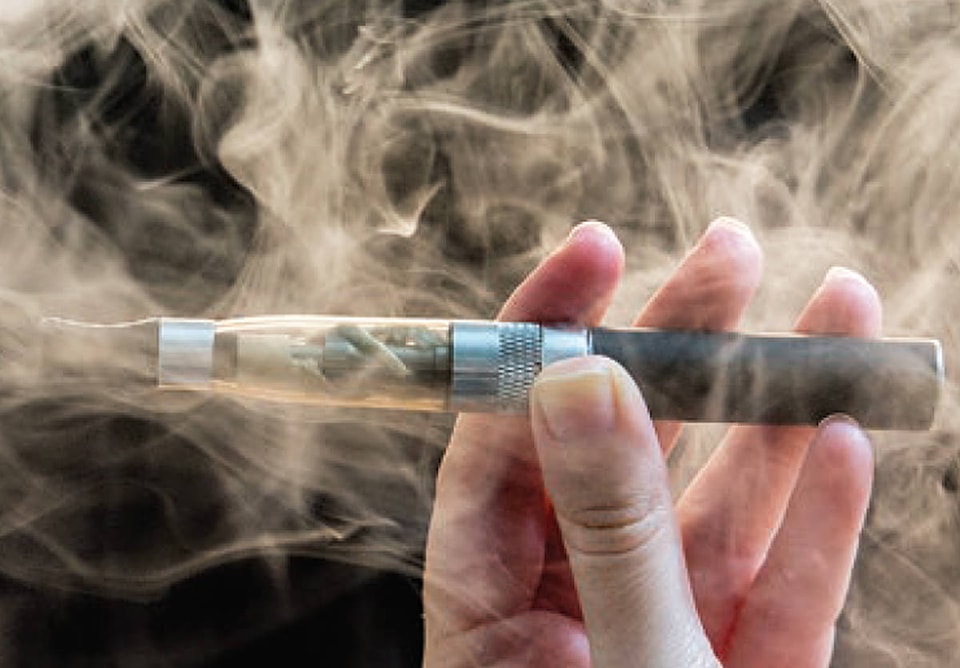In recent years, there has been an increase in the usage of vape pens and their elements, including mods – box or pod – and tanks. These devices are battery-powered and heat a liquid solution to create an aerosol – vapour or cloud.
E-cigarettes or vaping devices were first marketed by tobacco companies as a smoking cessation tool. However, they have evolved into a lifestyle product.
Of particular concern is the rise in use of vaping products among the youth in our community. Their popularity is due in part to availability, the variety of flavoured products and the ever-expanding and novel design and technology of the devices.
Some youth vape because their friends do so, or because the devices look cool, and they consider it less harmful than smoking.
RELATED: Many teens don’t know they’re vaping nicotine, Health Canada finds.
The most recent studies, however, indicate that most e-cigarettes contain and or emit numerous potentially toxic substances, such as heavy metals and tobacco.
While there is no specific figure on how much safer use of these products is compared to smoking tobacco, long-term use of e-cigarettes is expected to increase the risk of chronic obstructive pulmonary disease (COPD), lung cancer, and possibly cardiovascular disease, as well as some others associated with smoking.
In addition to these consequences, the usage of nicotine is a concern. Nicotine is a chemical found naturally in tobacco leaves and is present in most e-juices.
When the aerosol is inhaled, nicotine reaches the brain rapidly. The immediate response to nicotine includes increased heart rate and blood pressure.
Youth are particularly susceptible to the negative effects of nicotine as their brains continue to develop until about 25 years of age. Nicotine use during this period can alter brain development, effect memory, concentration, mood, and impulse control.
Nicotine is highly addictive – products that contain nicotine can lead to addiction and physical dependence.
Secondhand exposure to the aerosol, through close proximity to someone who is using a vaping device, can also lead to respiratory and cardiovascular health effects.
The exact impact on health continues to be studied.
E-cigarettes and vaping devices are also known to explode, causing burns and projectile injuries. The root cause of these explosions and fires appears to be the lithium-ion batteries, particularly if they are not properly used, stored, carried, or charged.
In order to protect the public and vulnerable populations, including our youth, regulations have been put into place federally and provincially.
At the federal level, Health Canada’s Tobacco and Vaping Products Act (TVPA) was enacted in May 2018 to regulate the manufacture, sale, labeling, and promotion of tobacco and vaping products. This act aims to prohibit the sale of vaping products to those under 18 years of age and restricts the promotion of vaping products that are appealing to youth, such as candy and dessert flavoured e-liquids.
In British Columbia, the B.C. Tobacco and Vapour Products Control Act (TVPCA) prohibits the sale of vaping products to those under 19 years of age and regulates how stores display the products so they are the same as tobacco. The act also bans the use of vaping products in all public spaces where tobacco smoking is currently banned, including school property.
Municipalities have the ability to further regulate the usage and sales of vaping products by passing new bylaws or amending current smoking bylaws to address this issue. Through zoning regulations, municipalities also have the power to regulate where vape shops are located and the density of such shops in a given neighbourhood.
Fraser Health has been working closely with our school district to review the best current evidence regarding potential health consequences of vaping or e-cigarettes, as well as discuss strategies to engage in productive dialogue with youth so they can make informed decisions about their use.
We will continue to work with our municipal and community partners to ensure accurate, evidence-based information is available.
It is recommended to have honest conversations of the pros and cons of e-cigarette or vaping products are discussed. Much like discussions about substance use, avoid criticism and encourage an open dialogue, and lastly be patient and ready to listen. Visit the Fraser Health website for more information about how to facilitate these important conversations.
– Contributed by Fraser Health staff Dorri Mahdaviani, MPH, Community Health Specialist, Healthy Living/Healthier Communities and Dorota Michalska, RN, Healthy Schools Program Nurse. Fraser Health is one of many organizations providing services in our community. The Maple Ridge-Pitt Meadows Community Network brings these organizations together for networking, capacity building and strategic planning.
